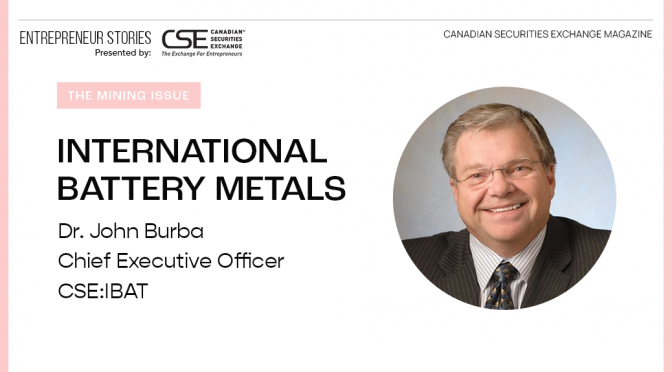Technological breakthroughs are where the big money is often made in the stock market, and International Battery Metals (CSE:IBAT) is a perfect example. As it entered the fourth quarter of 2020, the company’s shares could be picked up for around $0.10. More recently, those same shares have changed hands as high as $7.40.
It is a success story based on solutions in an industry crying out for them, one where inefficiency is clashing with a generational shift in consumption to create high prices and serious concerns about future supply shortages. Given the move toward greener economies, not to mention regional resource security, it might not come as a surprise that lithium is the prized product we are talking about.
International Battery Metals Chief Executive Officer Dr. John Burba can truly be described as a technology pioneer in the lithium extraction industry. Now at the helm of his own company, the pace of his achievements is only picking up momentum.
Dr. Burba spoke with Canadian Securities Exchange Magazine in late March about the company’s technology and how he sees it contributing to a better macro climate for the lithium industry, and the global environment, in the years ahead.
We will explore your technology and the company’s success in a moment, but can you begin with your view on the state of lithium supply and demand and how it shapes your strategy?
I’ll start off by saying that I think the lithium industry today is where the oil and gas industry was in about 1910. There are strong analogies.
If you go back to what was happening in the early 20th century, people did not really know much about how to get oil and gas out of the ground successfully. The process was very dirty. Pollution was ignored. It was just a nasty process. Of course, that has improved in the decades since.
The lithium industry is not that different. There are two major supplies of lithium today. There is hard rock mining, which is spodumene. Basically, companies are mining this in a variety of places and sending it to China for processing.
Then there is lithium extraction from brines, and you either have solar evaporation, which is very damaging, or you have FMC’s process, which I invented when I worked for FMC. That approach is better but still has drawbacks.
The industry has old processes that are not as efficient as they need to be, and significant issues on top of that with environmental damage. That is the backdrop to where we are. We have a tremendous shortage looming over us, and that is why prices are so high for lithium right now.
If the world continues producing lithium the way it does, the shortages are going to get worse. It will negatively impact the number of vehicles that can be produced and the number of batteries that can be produced. People will start using less efficient batteries and that is not going to be good for the transition we hope to see.
Can you quantify industry efficiency for us?
To give you a few examples, recovery rates for these processes are not very high. If you look at solar evaporation in Chile, they only recover about 20% to 30% of the lithium and the rest is wasted on the desert floor. FMC’s process recovers around 40% to 45% of the lithium.
Lithium is the only industry I’m aware of that tolerates such abysmal recovery rates. Most industries would be going crazy if they were wasting over 50% of their desired product.
So, these are the burdens that this industry is bearing right now. And the answer is not going to come from big established companies. They are simply not capable of, or not interested in, radically changing the industry so that it becomes efficient and responsive to the needs of the world.
In a recent press release, Universidad de Santiago de Chile stated that your technology is the “only one capable of separating lithium without leaving a significant impact on the environment.” Walk us through what differentiates your approach.
When you look at lithium extraction, one hears a lot about direct lithium extraction (DLE), and many start-up companies preach that as if it’s some new thing. The DLE concept actually began at Dow Chemical in the late 1970s and the 1980s, so that idea has been around for a long time.
Basically, it is about having a technology that can selectively pull lithium from the brine and let everything else go by. We are using a proven form of direct lithium extraction that is based on an absorbent that a friend of mine and I invented back in the 1990s. We have improved it since then, but it was groundbreaking at the time.
This material will selectively recover lithium from a saturated brine. And the selectivity is astronomically high.
The reason that matters is because there is not that much lithium in even the best resources. In that Atacama brine that everybody loves, you have about 2,000 parts per million lithium. If you look at Alberta, you are talking about 50 to 80 parts per million.
The lithium concentrations are low and you have to have something that will pick up the lithium and leave behind everything else.
We have improved our process so that – and we still have to prove this – but we are expecting to see recovery rates substantially higher than 60%. And we are hoping for recovery rates in the range of 90% to 95%.
The second thing is we intend to inject the brine back into the formation rather than putting it onto the ground and letting it evaporate. The problem with letting it evaporate is that you create salt flats all over the place, and salt is very detrimental to ecology.
The third thing, and perhaps the most important for jurisdictions such as Chile, is that our technology enables us to recover vast amounts of water. We will be recycling about 98% of our process water. In the Atacama, for example, they don’t recycle any water with solar evaporation.
What about the equipment itself? Are there positive environmental aspects to your physical footprint at a project?
We have been able to shrink the size of the processing equipment and that has allowed us to modularize and develop a mobile plant concept. We can put modular equipment in place, assemble it, turn it on and begin processing lithium in a short period of time.
When we are done, we pick up the equipment and eventually you won’t be able to tell that we were ever there. We can build one of these plants in months, rather than years.
I will add that our omnibus patent for this mobile and modular process has been issued.
What is the status in terms of commercialization? And what is the commercialization plan?
I’m glad you brought that up, because if we can’t make money, we can’t do a good job on the environment. We have two contracts with a company called Scorcia Minerals. They have substantial resources and we have a contract with them in Chile and Argentina providing exclusive rights to use our equipment there.
Our arrangement sees us receive a royalty on final sale of the product. They buy the equipment from us on a cost-plus basis, we operate on a cost-plus basis, and we own 10% of each project.
We are focused on North America right now and I would say that in the next two years we intend to have one of our units extracting lithium in the United States. We also intend to build a lithium carbonate hydroxide facility in the United States so that we have a North American base for significant lithium production.
Once we are established in North America, we are also open to Africa, Europe and other places where they have good resources.
Give us a look at your future and where the industry is going. How big do you think you can get and how does your company maintain a leadership position?
We have passed a tipping point from the standpoint of transportation and electrification. In the first question, I made the analogy to the oil industry a hundred years ago. I think lithium is going to see a lot of the same drive that oil did.
Some people will ask why not sodium, or why not potassium? It comes down to basic chemistry. Lithium is the best. Its transport numbers are the fastest, which means it will zip across a cell very rapidly, and go into crystals very rapidly, and it has a very high half-cell potential. So, when you look at this, all of it bodes well for powerful, high-capacity batteries. It is not likely we are going to find a battery chemistry that works better than lithium.
And then how do we remain relevant? We have to do every one of our projects in a credible and honest way and we have to be successful in everything that we say. We are not into predicting. We want to do it and then explain what we’ve done. Our accomplishments need to be real and measurable. That is the kind of thing that serious investors like.
Anything we have missed?
Right now, the biggest driver of success in the industry is time to market. We have exceedingly high prices. If I can start today and have a plant operating in 18 months, as opposed to six years, I have already won the game. That is where the mobile and modular extraction comes into play. We can get in rapidly, and we can expand a facility rapidly. It is like LEGO – you just plug it in.
I’d also point out that high recovery rates and things of that nature flow through to low operating costs. And something we have not talked about is that capital costs for our modular system are substantially lower than for traditional plants. We don’t have to put in foundations or construct big buildings. We don’t have a cast of thousands to support 24 hours a day. This makes it much easier to finance a plant and that makes it easier for us to expand. These are the reasons I am very optimistic about our future.
This story was featured in the Canadian Securities Exchange magazine.
Learn more about International Battery Metals at https://www.ibatterymetals.com/.


